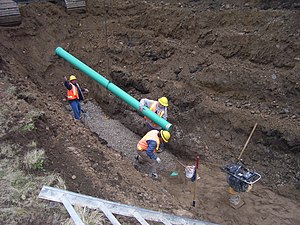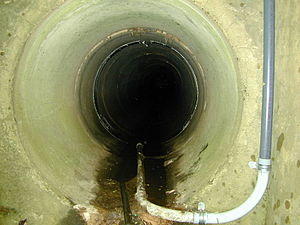Sanitary sewer




A sanitary sewer (also called a foul sewer) is a separate underground carriage system specifically for transporting sewage from houses and commercial buildings to treatment or disposal. Sanitary sewers serving industrial areas also carry industrial wastewater. The 'system of sewers' is called sewerage.
Sanitary sewers are operated separately and independently of storm drains, which carry the runoff of rain and other water which wash into city streets.[1]: Ch.I [2] Sewers carrying both sewage and stormwater together are called combined sewers.
Nomenclature
In the developed world, sewers are usually pipelines that begin with connecting pipes from buildings to one or more levels of larger underground trunk mains, which transport the sewage to sewage treatment facilities. Vertical pipes, called manholes, connect the mains to the surface. The manholes are used for access to the sewer pipes for inspection and maintenance, and as a means to vent sewer gases. They also facilitate vertical and horizontal angles in otherwise straight pipelines. Sewers are generally gravity powered, though pumps may be used if necessary. The most commonly used sanitary pipe is SDR-35 (standard dimension ratio), with smaller sized laterals interconnected within a larger sized main.[citation needed]
Pipes conveying sewage from an individual building to a common gravity sewer line are called laterals. Branch sewers typically run under streets receiving laterals from buildings along that street and discharge by gravity into trunk sewers at manholes. Larger cities may have sewers called interceptors receiving flow from multiple trunk sewers. A lift station is a gravity sewer sump with a pump to lift accumulated sewage to a higher elevation. The pump may discharge to another gravity sewer at that location or may discharge through a pressurized force main to some distant location.[3]
History
As an outgrowth of the Industrial Revolution, many cities in Europe and North America grew in the 19th century, frequently leading to crowding and increasing concerns about public health.[4] As part of a trend of municipal sanitation programs in the late 19th and 20th centuries, many cities constructed extensive sewer systems to help control outbreaks of disease such as typhoid and cholera.[2]: 29–34 Initially these systems discharged sewage directly to surface waters without treatment. As pollution of water bodies became a concern, cities added sewage treatment plants to their systems. Most cities in the United States underwent their sanitary revolutions between 1900 and 1935, by adding more expensive sewer systems and other technology to rid themselves of bad bacteria by chlorinating water and filtering water and sewage. In areas where there was surface pollution near the shore, such as Cleveland, extended intake systems were put out into the water to reduce contamination in drinking water. In cities during this period, there were reductions in diseases, such as typhoid fever which went from 35 per 10,000 to less than 5 per 10,000 in the population.[5] These early sewer systems can be accredited with a rise in population in cities because life expectancy increased and disease went down.
Maintenance
All sewers deteriorate with age; but Infiltration/Inflow is a problem unique to sanitary sewers; since both combined sewers and storm drains are sized to carry these contributions. Holding infiltration to acceptable levels requires a higher standard of maintenance than necessary for structural integrity considerations of combined sewers.[6] A comprehensive construction inspection program is required to prevent inappropriate connection of cellar, yard, and roof drains to sanitary sewers.[7] The probability of inappropriate connections is higher where combined sewers and sanitary sewers are found in close proximity; because construction personnel may not recognize the difference. Many older cities still use combined sewers while adjacent suburbs were built with separate sanitary sewers.
Simplified sewers
Simplified sanitary sewers consist of small-diameter pipes (typically 100 mm or about 4 inches), often laid at fairly flat gradients (1 in 200). The investment cost for sanitary sewers can be about half the costs of conventional sewers. However, the requirements for operation and maintenance are usually higher. Simplified sewers are most common in Brazil and are also used in a number of other developing countries.
See also
- Buchan trap
- Combined sewer
- Sanitary sewer overflow (SSO)
- Sewage treatment
- Stormwater
- Water pollution
- Composting toilet
References
- ^ Leonard Metcalf, Harrison P. Eddy (1922). Sewerage and Sewage Disposal: A Textbook. (New York: McGraw-Hill.)
- ^ a b Cady Staley, George S. Pierson (1899). The Separate System of Sewerage, Its Theory and Construction. (New York: Van Nostrand.)
- ^ American Society of Civil Engineers and Water Pollution Control Federation Design and Construction of Sanitary and Storm Sewers (1969) pp.2&288
- ^ Steven J. Burian, Stephan J. Nix, Robert E. Pitt, and S. Rocky Durrans (2000). "Urban Wastewater Management in the United States: Past, Present, and Future." Journal of Urban Technology, Vol. 7, No. 3, pp. 33-62. doi:10.1080/713684134.
- ^ Cutler, David and Miller, Grant, "The Role of Public Health Improvements in Health Advances: The 20th Century United States", The Role of Public Health Improvements in Health Advances, February 2004
- ^ Hammer, Mark J. Water and Waste-Water Technology (1975) John Wiley & Sons ISBN 0-471-34726-4 p.442
- ^ Steel, E.W. and McGhee, Terence J. Water Supply and Sewerage (1979) McGraw-Hill ISBN 0-07-060929-2 p.22
External links
- Experiences and Challenges in Sewers: Measurements and Hydrodynamics (2008), International Meeting on Measurements and Hydraulics of Sewers IMMHS'08, Hydraulic Model Report No. CH70/08, University of Queensland, Brisbane, Australia, 114 pages (ISBN 9781864999280)
